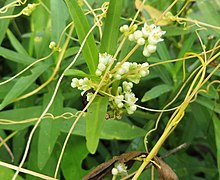| Cuscuta pentagona | |
|---|---|

| |
| Cuscuta pentagona flowers | |
| Conservation status | |
 Secure (NatureServe) | |
| Scientific classification | |
| Kingdom: | Plantae |
| Clade: | Tracheophytes |
| Clade: | Angiosperms |
| Clade: | Eudicots |
| Clade: | Asterids |
| Order: | Solanales |
| Family: | Convolvulaceae |
| Genus: | Cuscuta |
| Species: | C. pentagona |
| Binomial name | |
| Cuscuta pentagona Engelm. | |
Cuscuta pentagona, the fiveangled dodder, is a parasitic plant in the morning glory family Convolvulaceae. It is native to North America, where it is widespread in the United States and Canada. Unlike the closely related C. campestris, it has not become established on other continents.
Cuscuta pentagona is a slender annual vine. It is parasitic on a wide range of herbaceous plants, but with particular emphasis on members of the aster family (Asteraceae).
Its typical natural habitat is in moist, open areas such as riverbanks, wet prairies, and pond edges. It is tolerant of disturbance, as can be found as a weed in fields and along roadsides.
References
- NatureServe (2024). "Cuscuta pentagona". Arlington, Virginia. Retrieved 7 February 2024.
- "Cuscuta pentagona". County-level distribution map from the North American Plant Atlas (NAPA). Biota of North America Program (BONAP). 2014. Retrieved 30 May 2019.
- Costea, M.; Nesom, G.L.; Stefanović, S. (2006). "Taxonomy of the Cuscuta pentagona complex (Convolvulaceae) in North America". SIDA, Contributions to Botany. 22 (1): 151–175. JSTOR 41968566.
- ^ Yatskievych, George (2006). Flora of Missouri, Volume 2. Missouri Botanical Garden Press. p. 942.
- Weakley, Alan (2015). "Flora of the Southern and Mid-Atlantic States".
| Taxon identifiers | |
|---|---|
| Cuscuta pentagona |
|
This Solanales article is a stub. You can help Misplaced Pages by expanding it. |
This article related to a parasitic plant is a stub. You can help Misplaced Pages by expanding it. |